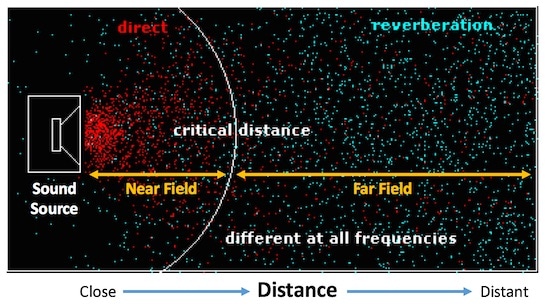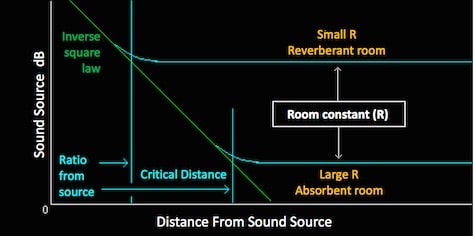Understanding how distance affects the transmission and intelligibility of sound is important to hearing care professionals. Understanding critical distance for sound helps the hearing professional counsel patients more effectively.
For some, attempting to apply formulae and actually make measurements is more than they want. Therefore, this post is an attempt to have a picture (or more than one) be worth a thousand words. Let’s start with Figure 1.

Figure 1. Direct sound from the speaker/talker/signal diminishes in level as a function of distance (modified from Lenard Audio Institute, education.lenardaudiocom).
From our studies on basic acoustics, it is known that the direct sound from the sound source diminishes in level as a function of the distance (inverse square law) – roughly falling at 6 dB for each doubling of distance. Indoors, where listening occurs most frequently, any reflected sound (from walls, ceilings, floors, other room surfaces) adds to the direct sound such that sound pressure no longer falls smoothly with distance. On the other hand, reverberation constantly spreads throughout the enclosure (room).
At close distances from a sound source, the direct sound is still stronger than any returning reflected sound. In a room, the direct sound falls at roughly 6dB for each doubling of distance, but it won’t be exactly 6 dB because of strong reflections from the walls, ceilings, floors, and other room objects/surfaces. Four or five dB reduction with distance doubling might be more realistic.
Regardless, as the distance from the source increases, the sound pressure of the direct sound continues to fall until it reaches the same intensity as that of the reverberant sound. This point is identified as the “Critical Distance.”
In basic acoustics, the direct sound from a source decreases in level as distance increases, typically around 6 dB for each doubling of distance. However, indoors, reflections contribute to the overall sound, causing a less smooth decrease in sound pressure with distance. The critical distance is the point where the intensity of the direct sound matches that of the reverberant sound, signaling a significant decrease in sound pressure as distance increases.
Stated another way, “Critical Distance” is the distance from the sound source where the direct and reverberant sound energies become equal (Figure 2).

Figure 2. The critical distance depends on the ratio (R) of the direct and reverberant sound. When the critical distance is close to the sound source, it indicates that the reverberation in the room is high. If the critical distance is distant from the sound source, the room has good absorbance. In a 100% absorbent room, the critical distance would be at the walls. The turquoise lines associated with the Small R and Large R indicate the sound level of the reverberation.
Every enclosed space has a critical distance value. When working closer to the sound source than the critical distance, this is said to be working in the “near (or direct) field.” When working farther away from the critical distance, this is said to be working in the “far (or reverberant) field.”
Take Away
- The more reverberant the room, the closer the Critical Distance
- The more absorbent the room, the further the Critical Distance
- Near field, or direct field, is inside the Critical Distance
- Far field, or reverberant field, is outside the Critical Distance
Wayne Staab, PhD, is an internationally recognized authority in hearing aids. As President of Dr. Wayne J. Staab and Associates, he is engaged in consulting, research, development, manufacturing, education, and marketing projects related to hearing. His professional career has included University teaching, hearing clinic work, hearing aid company management and sales, and extensive work with engineering in developing and bringing new technology and products to the discipline of hearing. This varied background allows him to couple manufacturing and business with the science of acoustics to bring innovative developments and insights to our discipline. Dr. Staab has authored numerous books, chapters, and articles related to hearing aids and their fitting, and is an internationally-requested presenter. He is a past President and past Executive Director of the American Auditory Society and a retired Fellow of the International Collegium of Rehabilitative Audiology.







